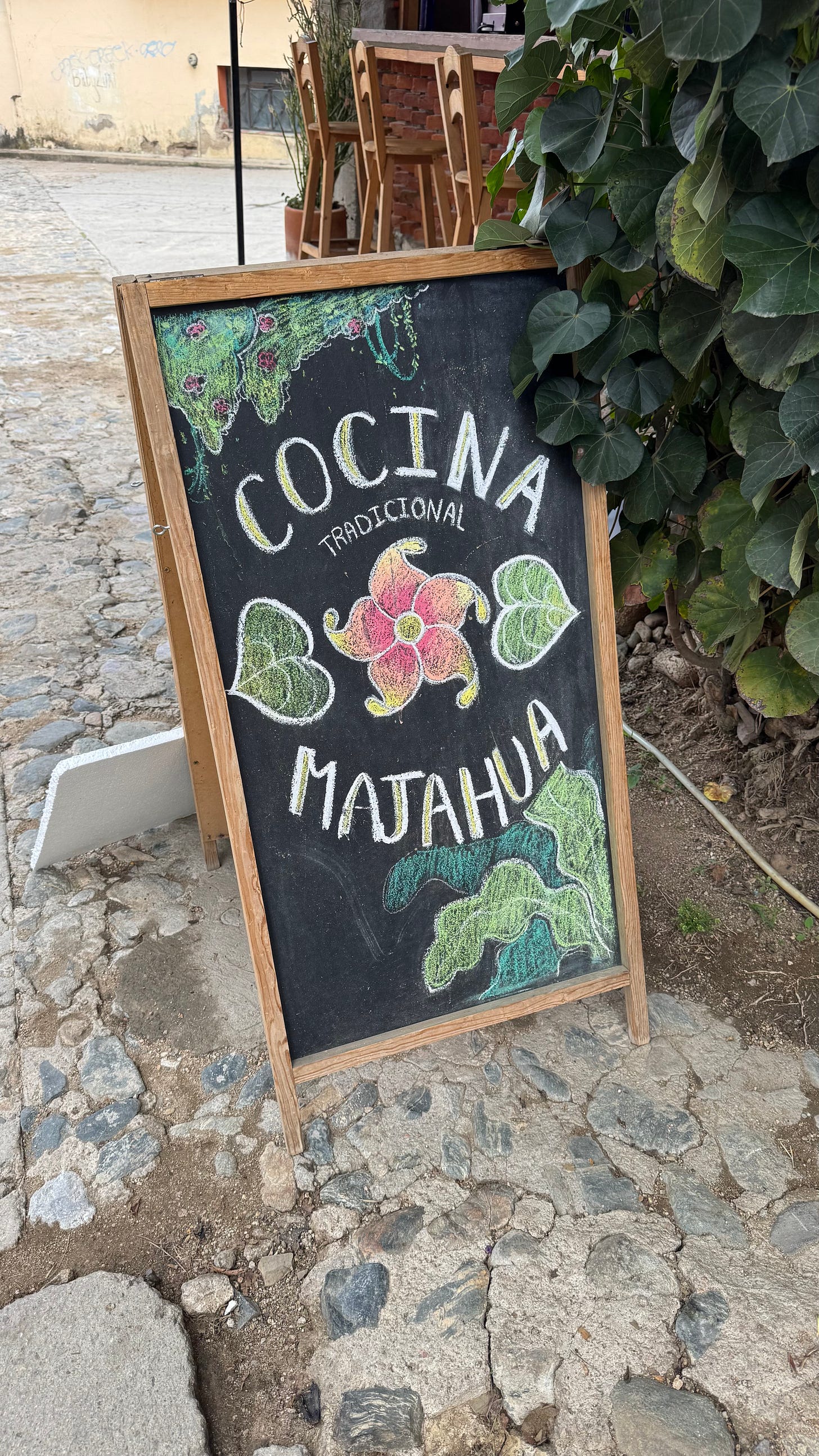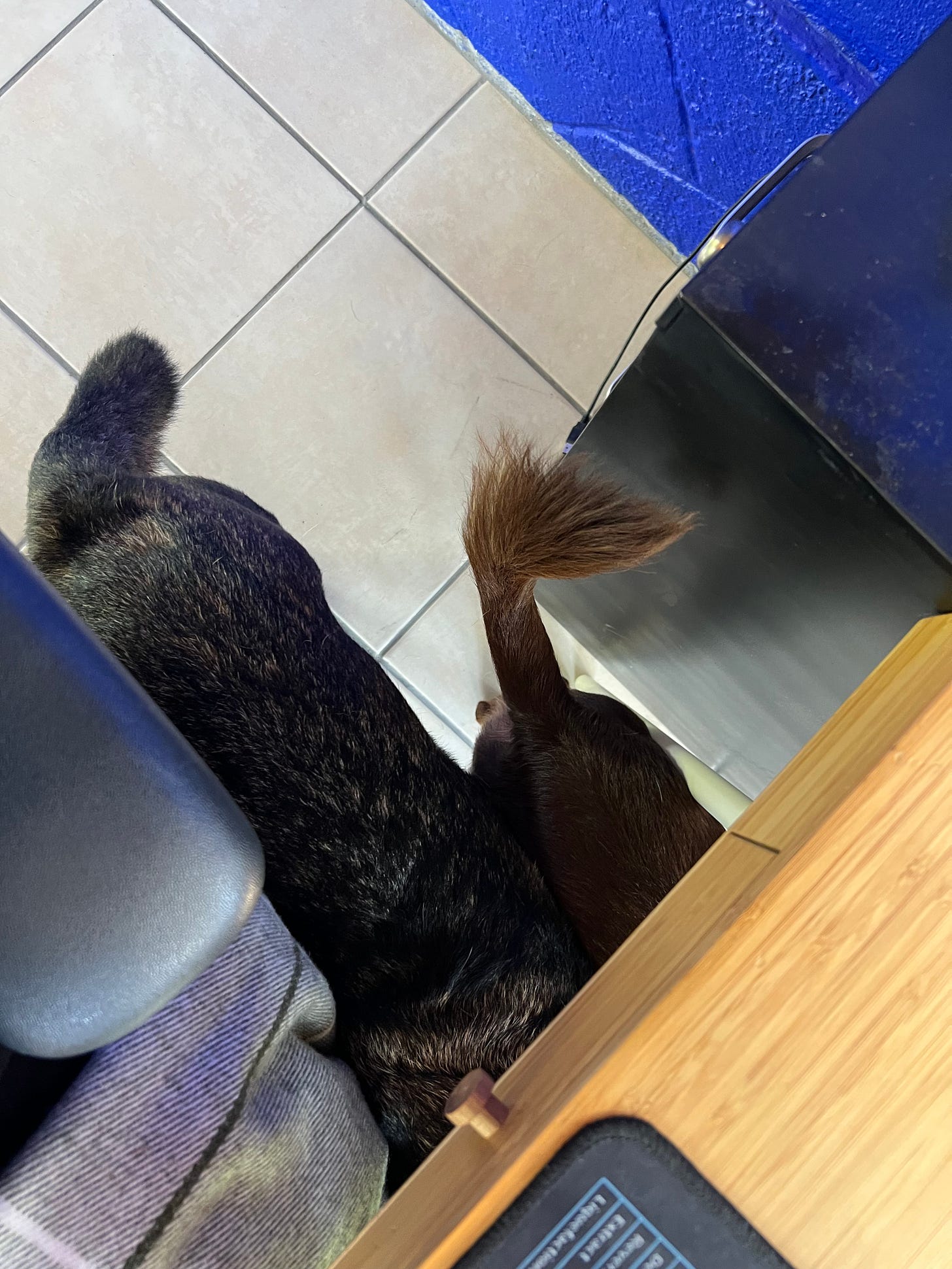A Goodbye, in English
We say farewell and good luck to someone we've known almost since first moving to Mexico.
Cocina Majahua sits on a small stretch of cobbled road in the village of San Sebastián Etla, its wooden door beckoning. We started eating there not long after moving to Mexico, drawn in by a desire to explore the food options near our house and because the restaurant was rustically charming in a way we initially had trouble defining. It was only after we had eaten there a few times that Andrea said to me, “I think we’re outside,” and we realized the restaurant isn’t actually indoors, but rather was built in what amounts to an alleyway courtyard that, some years ago, someone covered with a roof made of rippled plastic panels and aluminum sheeting. Adding to the charm, Majahua shares space with Melosos, a coffee shop run by a friendly curly-haired woman named Frida who takes great pride in her medium-roast espresso.
Those first few months of being an expat—that first year!—were so disorienting that finding restaurants where we could be regulars felt essential for our survival. Oaxaca is largely a welcoming place, but during our years in New York, we returned to our favorite restaurants with such frequency that at times we felt almost like we were being greeted by the hosts and waitstaff as friends and not as customers. We felt we had already found that at Frida Libre, but Oaxaca, a state famed for its spectacular cuisine, rewards those willing to explore, and we wanted to have more than just one restaurant we could love and trust. We found that in Majahua and were charmed not just by its ambiance but by its owners, the petite Doña Cris, a quintessential Mexican abuela who in her shoes stands at less than five feet tall, and her warm and enthusiastic granddaughter Angie, an enterprising, baby-loving woman in her early 30s.
It didn’t take many visits for us to be greeted warmly by both Doña Cris and Angie whenever we entered the restaurant, but after a few months, we began to notice that Majahua seemed to have trouble holding onto its kitchen staff and servers. “Is that another new person in the kitchen?” I said to Andrea during one early visit after nudging her and gesturing toward the kitchen. Through a rectangular window cut into the brick, we could see Angie, Doña Cris, and a person we’d never seen before fussing over a plate being garnished with fresh lettuce and Mexican crema.
“I think it is,” Andrea mused.
We were stumped. The women working there—it was always exclusively women—came and went with almost clockwork regularity, but there seemed to be no obvious reasons why an employee might leave after so brief a period of time. Not once did we hear screaming coming from the kitchen, and no servers ever rushed past us to hide their tears on the street or in a back room. While the brunch rush was always a time of chaos in the restaurant, the environment was typically fairly placid. None of the obvious causes of burnout seemed to be responsible for the turnover.
It didn’t take long for our curiosity to get the better of us, and one day at Andrea’s urging, I casually mentioned to Angie in Spanish, “Looks like you’ve got a new person in the kitchen!”
“Yes!” Angie replied. “She’s our latest volunteer.” Andrea and I looked at each other quizzically. Volunteer?
It turned out, some months before our trying to gently ask Angie about the surprisingly routine manner in which she and her grandmother gained and lost employees, she began posting to Facebook what amounted to a classified ad: if a woman was interested in visiting Oaxaca and working for free in the restaurant, in exchange they’d learn to cook Oaxacan food and would receive free room and board. It turned out to be an attractive offer for a surprisingly wide variety of women, and since then, at least five or six people, typically in their 20s and predominantly from Latin America, have cycled through the restaurant’s kitchen. They’ve come from Uruguay and Canada, other parts of Mexico, and so far, just one has hailed from the United States. But other than Angie, Doña Cris, and Frida, the only person who has consistently served us has been a young, thin, and forgetful woman with an alpaca haircut, round glasses, and a friendly but understated demeanor.
To our perpetual shame, we never managed to learn her name. We had grown so used to the rapid turnover of employees that at some point, we stopped introducing ourselves to them, and by the time we realized the woman with the alpaca haircut was there to stay, far too much time had passed for us to be able to properly introduce ourselves. Desperate to figure it out, but also ashamed to ask Angie, Doña Cris, or Frida, we turned to our other friends who also eat at Majahua. None of them knew either.
Our most recent trip to the United States came and went, and we realized that we hadn’t been to Majahua in far longer than we intended. To rectify the situation, this past Sunday, we loaded Leo into his car seat and drove the 10-minute journey to San Sebastián. While both Frida and Angie were absent that weekend, we were enthusiastically greeted by Doña Cris and our name-unknown-to-us server, both of whom doted over Leo after we had placed our order.
On the best of days, our server has proven to be forgetful, but this past Sunday was a chaotic low point. Dishes arrived out of order, and part of our drink order never made it to the table. At one point, we watched the server carry a tray of food out onto the road only to find that whoever had ordered it was nowhere to be found. Given that Majahua doesn’t have any outdoor seating, we felt just as puzzled as she was when she walked back in carrying the tray still loaded with food.
It was clear something was amiss, but we felt like asking her would indicate that we’d noticed things are even more uneven than they typically are. Eventually, we began to get ready to go, and while Andrea asked for the check, I decided to use the bathroom. I was washing my hands when I suddenly heard Andrea laugh and launch into an enthusiastic conversation in English. I wondered who she might have bumped into in the restaurant, and thought that perhaps she’d made us some new friends.
When I emerged from the bathroom, I discovered only Andrea and our server standing by the table. “What’s going on?” I asked. “Who were you talking to?”
“I was talking to Kesley!” Andrea said, gesturing towards our server, her name finally revealed. “Hello!” she said.
“YOU SPEAK ENGLISH?” I exclaimed in shock.
“I do,” she said sheepishly. As it turned out, she didn’t just speak English, she spoke excellent English.
We’ve always felt that it’s our responsibility to learn to speak Spanish and that it’s not on Mexico to accommodate our nascent language skills, and so whenever we enter into any sort of interaction here in Oaxaca, we do so first in Spanish. That’s how we had always greeted Kesley and how we’ve always ordered in Majahua, and for the entire time Kesley had been waiting on us, many months, she had never spoken a word of English. That was neither a surprise nor a disappointment, as most people in Oaxaca don’t speak English, including Angie and Doña Cris.
After two years of interacting with her solely en español, Kesley, while walking by our table, spied a large but fading birthmark that sits on the back of Leo’s head where his neck meets the base of his skull, and exclaimed, “Oh look, he has a birthmark!” Andrea’s loud laugh and exclamation that I heard mutedly from the bathroom was her own reaction to discovering Kesley’s previously hidden language skills.
Once the language barrier was broken, Andrea, whose Spanish remains in early development, was free to finally dig for more information. The reason Kesley was more out of sorts than usual was because, as had been the case for so many other servers, it was her last day working at the restaurant. She had gotten into culinary school in Oaxaca and would be learning to become a mixologist.
We were thrilled for her, and also sad and puzzled in equal measure. Sad because she was someone we’d known, if perhaps a bit impersonally, from very early on in our tenure in Oaxaca, and because if we’d known she spoke English, we certainly would have spoken with her more meaningfully and learned more about her. But we were also puzzled, bordering on feeling vexed. Our early days in Oaxaca were made much harder by the fact that our Spanish was so limited, and there were many times when Kesley, seeing us struggle with basic communication, could have chimed in to make things a bit easier for us.
When I had been in the bathroom, Andrea, direct as ever, did ask her why she had only chosen to speak to us in Spanish. “Well,” she explained, “Most of our clients who speak English are learning Spanish and want to practice, and so I figured you guys would want to also.” It was a considerate approach, if perhaps also a bit naive. There were times, especially early on, when we had visibly struggled with a task as simple as ordering a meal, to the point that some mercy would have been appreciated. Sometimes, having a stress-free breakfast trumps linguistic improvement.
We were happy to be able to say a proper goodbye, though, and to wish her luck. While she’ll still be in Oaxaca, and perhaps we’ll see her again some day on the street, or perhaps even working behind the bar of a restaurant, it did feel like a farewell. At least after almost two years, we got to learn her name, and to say goodbye, unexpectedly, in a language we can all understand.






Hi there, fellow expat living in Queretaro since 2018👋
My husband's family is from Veracruz and Oaxaca.
Oaxaca is the type of city that is magic and honestly rewires your soul. I am enjoying your posts ❤️
Great story! As an expat in NL, locals often change over to English when I use my elementary Dutch. It’s challenging! Thanks for sharing.